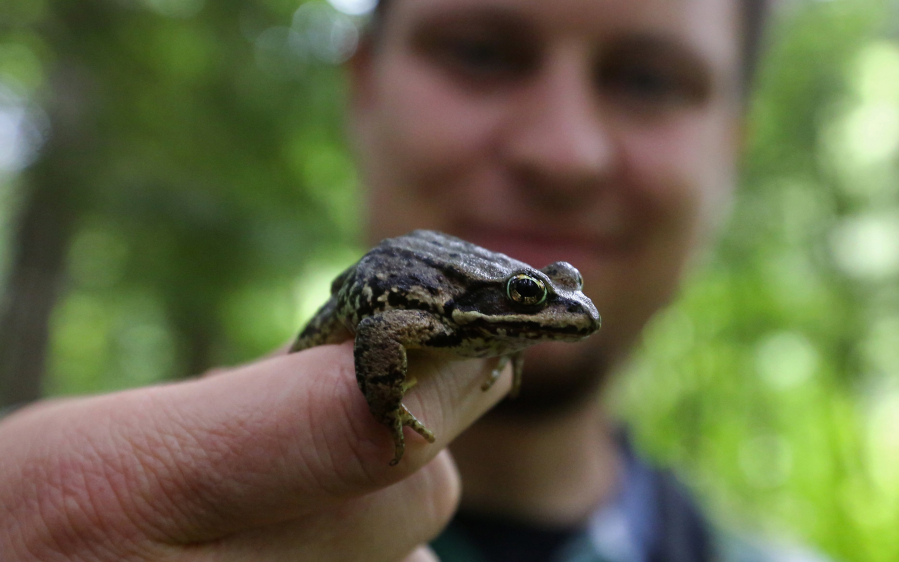Tacoma — You can hear it in the morning and the evening. It comes from trees, behind bushes and under leaves.
Ribbit. Ribbit. Ribbit.
It’s spring — when a young frog’s fancy lightly turns to thoughts of love.
OK, we can’t say for sure if frogs have the same emotions as humans, but the chorus of croaks coming from the swampier areas of Pierce and Thurston counties are definitely mating calls.
So says Max Lambert, an aquatic habitat research scientist with the state Department of Fish and Wildlife.
“They’re basically trying to say, ‘Here I am, let’s get this done,’ ” he said. And, yes, it’s the males making all the noise.
There’s no candle-lit dinner needed for frog romance, just a sturdy blade of grass in a watery love nest and vocal chords to advertise it.
Song of the frog
Mating season, with its corresponding come-hither calls, has been occurring in fits and starts this year due to periods of warm weather followed by cold, Lambert said.
There are several species of frogs in the South Sound, and all are on different mating schedules, Lambert said.
The Oregon spotted frog, a federally listed threatened species, typically lays its eggs in a span of days lasting just a couple of weeks at most.
“They’ve been kind of trickling their eggs out over a much longer time frame this year because of probably the kind of start-stop weather we’ve been having,” he said.
Know your frogs
The brownish Oregon spotted frog isn’t an invader from Portland looking for cheaper rent. It was named during the days of the Oregon Territory, from which Washington state was carved.
The chorus frog, a genus so named because of its vocal talents, is up to hanky-panky as well this spring and wants somebody to know about it. The green frog has distinctive black bands streaking back from its eyes, like mascara applied in a wind tunnel.
The northern red-legged frog can be found in lowland waterways. It has its namesake red legs and underside.
The higher elevations of Washington contain their own species. It might be hard to believe that frogs survive in areas populated in winter by skiers and cursing drivers installing tire chains. Some species have a natural antifreeze and undergo a bearlike hibernation.
The Cascades frog lives as high as 7,000 feet in alpine lakes in both its namesake mountains and the Olympic range. In the winter, they settle in the unfrozen bottoms of the lakes.
“They basically stop their metabolism,” Lambert said.
Helping web-footed friends
While it might feel good to help a toad cross a road, habitat is the key to frog health, Lambert said. Good habitat, it turns out, begins at home.
Plant shrubs, plant trees and don’t dispose of fall leaves, Lambert advised. Instead, rake them underneath those shrubs or on to bare earth in fall.
“That layer of leaf litter is where they can hide as they’re moving around the ground,” he said. “When you rake stuff up, you obliterate all habitat for the animals to move around safely, not get picked up by predators.”
The leaf litter also feeds numerous species of invertebrates — the happy meals for amphibians.
Leafy gardens are fine, but frogs and their kind still need fresh water to complete their life cycle. That, said Lambert, is an increasing rarity in the Puget Sound region. Washington has lost as much as half of its ponds and wetlands, he said.
“Which is an insane number to think about — that we lost half of them,” he said.
There is some good news. Frogs aren’t picky and can do just fine in stormwater retention ponds, Lambert said. They can even reproduce in a rainy season puddle if it sticks around long enough. A pond that dries up in the summer won’t hold fish — one less predator for frogs to worry their little green heads about. People who have ponds might want to consider local amphibian health before adding fish.
“Thinking about the kind of critters that we’re adding into our habitats is a pretty big important part of the story,” he said.
Learning more
Lambert encourages people to get to know their local amphibians just like birders know their robins from their jays.
The website and smartphone application iNaturalist can help identify amphibians and other wildlife.
“It’s really cool, for not only documenting what you see, but seeing what other folks have seen around you,” he said.
Lambert also suggests amphibiaweb.org, a UC Berkeley-based website.
“It’s an army of scientists that curate thousands of amphibian species across the world,” he said. “And their natural history, the biology kind of conservation information. Pretty much all of our species here in the Northwest are on there.”



